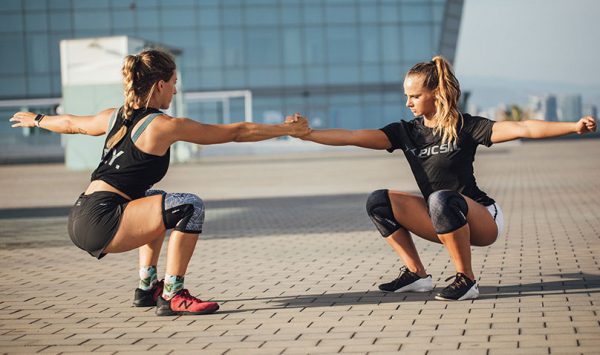When you start in Cross Training there are many questions that arise. From what Hspu means to what type of accessories are the best and most advised. In addition to the Grips, accessory par excellence in Cross Training, the protection elements such as belt And kneers play a very important role. If you want to know what the Cross Training Kneewars And what guy use, you can't miss this post!
What are Cross Training knee pads?
As protection article, The kneewars serve to give extra support to our articulation and prevent future injuries. The knee They contribute compression and heat to the area, absorbing the load and preventing the knees from supporting so much weight. Thanks to the cross training kneewars we can Increase performance of our training since they increase blood irrigation and reduce knee swelling during and after training, so recovery will be more optimal. An important point in which we have to emphasize is that cross training kneers are not the same as orthopedic kneelets. The latter serve to recover from an injury and in no way the knees of Cross Training will fulfill that function.
When to use kneelets?
The knee, as we have mentioned before, serve as Extra support. Esto quiere decir, que lo primero a tener en cuenta es que debemos tener la zona bien trabajada. In this case, for a good support, the muscles attached to the joint must be strong to serve as protection and avoid future injuries. Cross Training kneewars will help us increase the force in the exercise. The most indicated exercises in which we can use them are in Squats, Clean, Snatch, Lunges, pistols... any exercise that requires that game in the articulation. They are also usually used as pimples To avoid friction in this area, either with the bar or with the rope.
Types of knee
The kneewins that are usually used in Cross Training are made with neoprene. The level of compression of this material is medium, causing the kneewins to serve to prevent injuries and provide sufficient heat to the joint. An important fact that we have to take into account is the Knee thickness. At the moment In PICSIL we have 2 thicknesses, 5mm and 7mm. The thickness of the knee you need will depend on the type of activity you do.
5mm kneelets for Cross Training
The 5mm kneelets They are the most versatile. They are designed to adapt to all Wods. Thanks to this knee thickness, agility is preserved while the joint is protected. The 5M kneewilings allow the range of any movement, although they can also be used for weightlifting.
7mm kneelets for Cross Training
The 7mm kneelets They are ideal for the heaviest jobs. Thanks to the thickness, the support and support of the joint is greater. They give greater stability and knee control. HE collect in exercises exclusively of force, such as RMS.
What size I choose?
The objective of the kneewoman is that the joint is well held and protected. For this reason the knee has to be tight- but you do not pass, the blood has to keep circulating, haha.- Next, we leave you a table that will guide you to choose your size.
Maintenance and Knee Wash
To ensure the durability and functionality of your cross training knees, it is important to follow these maintenance and washing tips:
-
Lippial them regularly: Eliminates sweat and dirt after each use to prevent bad odors and accumulation of bacteria.
-
Handwashing: Wash the knee by hand using warm water and a soft detergent. Avoid the use of bleaching or aggressive products that can damage the materials.
-
Adequate drying: Let the knee dry outdoors, preferably in an ventilated place and far from the direct light of the sun. Avoid the use of dryers, since excessive heat can deform them.
-
Adequate storage: Guard them in a clean and dry place when you are not using them. Avoid folding or leaving heavy objects on top, since this could affect their shape and elasticity.
-
Regular inspection: Check the knee periodically in search of wear, loose seams or any damage. If you find any problem, consider replacing them to maintain optimal protection.
Following these tips, you can keep your cross training knees in good condition, prolonging its useful life and ensuring effective protection during your training sessions.
We hope you liked it. You can leave us in comments all the doubts you have. See you soon!















